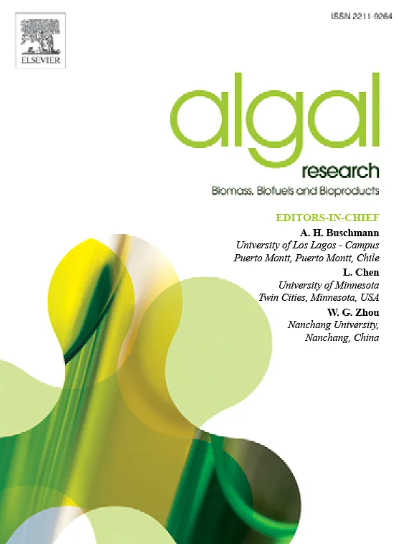Compliance assessment oriented microcystin prediction: A Bayesian adaptive LASSO Tobit quantile regression approach
IF 4.6
2区 生物学
Q1 BIOTECHNOLOGY & APPLIED MICROBIOLOGY
Algal Research-Biomass Biofuels and Bioproducts
Pub Date : 2025-04-17
DOI:10.1016/j.algal.2025.104026
引用次数: 0
Abstract
Microcystin has been one of major contaminants impacting health of aquatic ecosystems and threatening human health. The development of drivers-microcystin relationship is of vital importance to microcystin management. However, current practices often focused on the mean response of microcystin concentration and cannot meet the requirement of percentile-based compliance assessment. Despite of many informative studies on the development of drivers–microcystin relationship, there remains a gap between the relationship development and the percentile-based compliance assessment of microcystin concentration. In this study, Bayesian adaptive LASSO Tobit quantile regression (BALTQR) model was introduced to environmental and ecological studies for the first time. The model is specially designed for the prediction of left-censored response variable. We applied the BALTQR model to develop the drivers–microcystin relationship of lakes across the US continent. Based on the results of parameters estimation, Chlorophyll a (CHL), pH, and water temperature (WT) were identified as key drivers to the microcystin concentration. We found that CHL was approximate the same important as pH and both of them had positive effects on the microcystin concentration at all the five regression quantiles. WT was relatively less important and had a surprisingly negative effect at the 0.7, 0.8, and 0.9 regression quantiles. We demonstrated that the BALTQR model successfully established the linkage between the development of drivers–microcystin relationship and the compliance assessment of microcystin concentration. We further revealed important implications of these findings to microcystin management. We believed that the BALTQR model has great potential of generalization to model other left-censored response variable in environmental and ecological studies.

面向依从性评估的微囊藻毒素预测:贝叶斯自适应LASSO Tobit分位数回归方法
微囊藻毒素已成为影响水生生态系统健康、威胁人类健康的主要污染物之一。建立驱动因子与微囊藻毒素的关系对微囊藻毒素的管理至关重要。然而,目前的做法往往侧重于微囊藻毒素浓度的平均反应,不能满足基于百分位数的依从性评估的要求。尽管有许多关于驱动因素与微囊藻毒素关系发展的信息性研究,但这种关系发展与基于百分位数的微囊藻毒素浓度依从性评估之间仍然存在差距。本研究首次将贝叶斯自适应LASSO Tobit分位回归(BALTQR)模型引入环境生态研究。该模型是专门为左截尾响应变量的预测而设计的。我们应用BALTQR模型开发了美国大陆湖泊的驱动因素-微囊藻毒素关系。根据参数估算结果,叶绿素a (CHL)、pH和水温(WT)是影响微囊藻毒素浓度的关键因素。我们发现CHL与pH的重要性大致相同,并且两者在所有五个回归分位数上都对微囊藻毒素浓度有积极影响。WT相对不那么重要,并且在0.7、0.8和0.9回归分位数上具有令人惊讶的负面影响。我们证明BALTQR模型成功地建立了驱动因子-微囊藻毒素关系的发展与微囊藻毒素浓度依从性评估之间的联系。我们进一步揭示了这些发现对微囊藻毒素管理的重要意义。我们认为BALTQR模型具有很大的推广潜力,可以在环境和生态研究中对其他左删减响应变量进行建模。
本文章由计算机程序翻译,如有差异,请以英文原文为准。
求助全文
约1分钟内获得全文
求助全文
来源期刊

Algal Research-Biomass Biofuels and Bioproducts
BIOTECHNOLOGY & APPLIED MICROBIOLOGY-
CiteScore
9.40
自引率
7.80%
发文量
332
期刊介绍:
Algal Research is an international phycology journal covering all areas of emerging technologies in algae biology, biomass production, cultivation, harvesting, extraction, bioproducts, biorefinery, engineering, and econometrics. Algae is defined to include cyanobacteria, microalgae, and protists and symbionts of interest in biotechnology. The journal publishes original research and reviews for the following scope: algal biology, including but not exclusive to: phylogeny, biodiversity, molecular traits, metabolic regulation, and genetic engineering, algal cultivation, e.g. phototrophic systems, heterotrophic systems, and mixotrophic systems, algal harvesting and extraction systems, biotechnology to convert algal biomass and components into biofuels and bioproducts, e.g., nutraceuticals, pharmaceuticals, animal feed, plastics, etc. algal products and their economic assessment
 求助内容:
求助内容: 应助结果提醒方式:
应助结果提醒方式:


